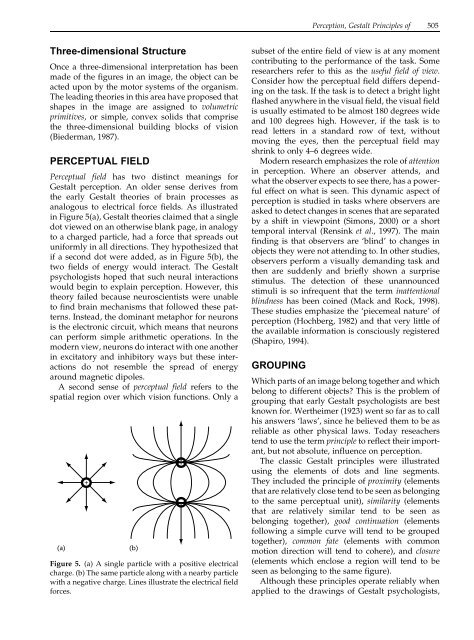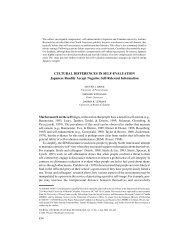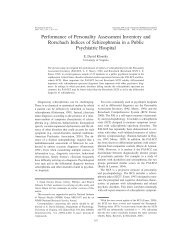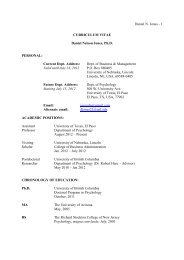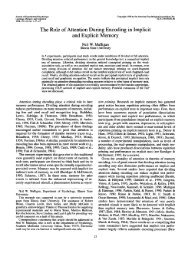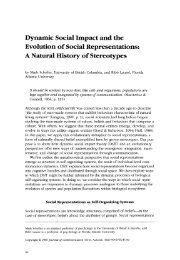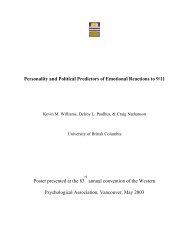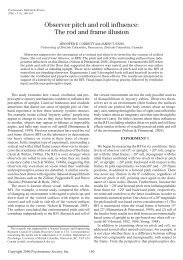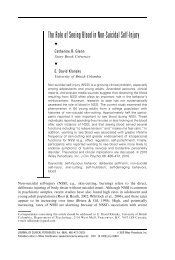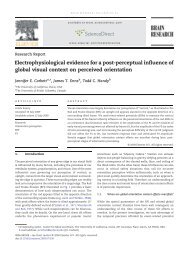Gestalt Grouping Principles - HomePage Server for UT Psychology
Gestalt Grouping Principles - HomePage Server for UT Psychology
Gestalt Grouping Principles - HomePage Server for UT Psychology
You also want an ePaper? Increase the reach of your titles
YUMPU automatically turns print PDFs into web optimized ePapers that Google loves.
Perception, <strong>Gestalt</strong> <strong>Principles</strong> of 505<br />
Three-dimensional Structure<br />
Once a three-dimensional interpretation has been<br />
made of the figures in an image, the object can be<br />
acted upon by the motor systems of the organism.<br />
The leading theories in this area have proposed that<br />
shapes in the image are assigned to volumetric<br />
primitives, or simple, convex solids that comprise<br />
the three-dimensional building blocks of vision<br />
(Biederman, 1987).<br />
PERCEPTUAL FIELD<br />
Perceptual field has two distinct meanings <strong>for</strong><br />
<strong>Gestalt</strong> perception. An older sense derives from<br />
the early <strong>Gestalt</strong> theories of brain processes as<br />
analogous to electrical <strong>for</strong>ce fields. As illustrated<br />
in Figure 5(a), <strong>Gestalt</strong> theories claimed that a single<br />
dot viewed on an otherwise blank page, in analogy<br />
to a charged particle, had a <strong>for</strong>ce that spreads out<br />
uni<strong>for</strong>mly in all directions. They hypothesized that<br />
if a second dot were added, as in Figure 5(b), the<br />
two fields of energy would interact. The <strong>Gestalt</strong><br />
psychologists hoped that such neural interactions<br />
would begin to explain perception. However, this<br />
theory failed because neuroscientists were unable<br />
to find brain mechanisms that followed these patterns.<br />
Instead, the dominant metaphor <strong>for</strong> neurons<br />
is the electronic circuit, which means that neurons<br />
can per<strong>for</strong>m simple arithmetic operations. In the<br />
modern view, neurons do interact with one another<br />
in excitatory and inhibitory ways but these interactions<br />
do not resemble the spread of energy<br />
around magnetic dipoles.<br />
A second sense of perceptual field refers to the<br />
spatial region over which vision functions. Only a<br />
(a)<br />
+<br />
(b)<br />
Figure 5. (a) A single particle with a positive electrical<br />
charge. (b) The same particle along with a nearby particle<br />
with a negative charge. Lines illustrate the electrical field<br />
<strong>for</strong>ces.<br />
subset of the entire field of view is at any moment<br />
contributing to the per<strong>for</strong>mance of the task. Some<br />
researchers refer to this as the useful field of view.<br />
Consider how the perceptual field differs depending<br />
on the task. If the task is to detect a bright light<br />
flashed anywhere in the visual field, the visual field<br />
is usually estimated to be almost 180 degrees wide<br />
and 100 degrees high. However, if the task is to<br />
read letters in a standard row of text, without<br />
moving the eyes, then the perceptual field may<br />
shrink to only 4±6 degrees wide.<br />
Modern research emphasizes the role of attention<br />
in perception. Where an observer attends, and<br />
what the observer expects to see there, has a powerful<br />
effect on what is seen. This dynamic aspect of<br />
perception is studied in tasks where observers are<br />
asked to detect changes in scenes that are separated<br />
by a shift in viewpoint (Simons, 2000) or a short<br />
temporal interval (Rensink et al., 1997). The main<br />
finding is that observers are `blind' to changes in<br />
objects they were not attending to. In other studies,<br />
observers per<strong>for</strong>m a visually demanding task and<br />
then are suddenly and briefly shown a surprise<br />
stimulus. The detection of these unannounced<br />
stimuli is so infrequent that the term inattentional<br />
blindness has been coined (Mack and Rock, 1998).<br />
These studies emphasize the `piecemeal nature' of<br />
perception (Hochberg, 1982) and that very little of<br />
the available in<strong>for</strong>mation is consciously registered<br />
(Shapiro, 1994).<br />
GROUPING<br />
Which parts of an image belong together and which<br />
belong to different objects? This is the problem of<br />
grouping that early <strong>Gestalt</strong> psychologists are best<br />
known <strong>for</strong>. Wertheimer (1923) went so far as to call<br />
his answers `laws', since he believed them to be as<br />
reliable as other physical laws. Today reseachers<br />
tend to use the term principle to reflect their important,<br />
but not absolute, influence on perception.<br />
The classic <strong>Gestalt</strong> principles were illustrated<br />
using the elements of dots and line segments.<br />
They included the principle of proximity (elements<br />
that are relatively close tend to be seen as belonging<br />
to the same perceptual unit), similarity (elements<br />
that are relatively similar tend to be seen as<br />
belonging together), good continuation (elements<br />
following a simple curve will tend to be grouped<br />
together), common fate (elements with common<br />
motion direction will tend to cohere), and closure<br />
(elements which enclose a region will tend to be<br />
seen as belonging to the same figure).<br />
Although these principles operate reliably when<br />
applied to the drawings of <strong>Gestalt</strong> psychologists,


